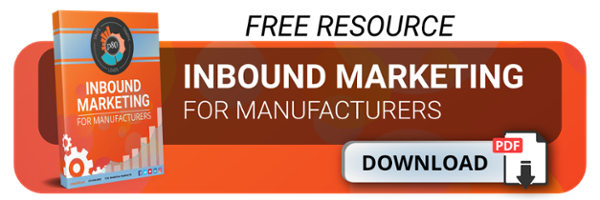Inbound Marketing Blog
for Manufacturers and Healthcare Companies
Social Media Cheat Sheet for Manufacturers

In a B2B climate, where most manufacturers exist, social media may not sound like a priority. Or, if social media is a priority, it’s one that often gets pushed aside due to tight turnaround times and small staffs. That’s why we created this social media cheat sheet for the little guys, the underdogs, or any company that working toward a commanding social media presence.
Social Media Cheat Sheet: 7 Quick Tips
Making your company’s presence felt on relevant social channels is important and worth it -- especially if you follow these seven concepts with a special bend toward small B2Bs:
- Get help & make it easy on yourself
- Set up a business account for each social channel
- Share your unique wisdom
- Be the little fish in the big pond
- Pay for small social campaigns
- Optimize your social pages
- Make sure your images meet platform guidelines
1. Get Help & Make It Easy on Yourself
If you can’t afford a multifaceted, robust social media tool like HubSpot, you can try one of the popular free tools, like Hootsuite. These platforms help you manage your social strategy and post on a schedule and in bulk. Very nice for the time-strapped manufacturer.
If you want to remove your staff even further from the headache of keeping up with social media, you can hire an inbound marketing agency to handle it (and just about anything else).
Either way, don’t put too much on 1-2 people. You’ll either fall behind schedule and fail to make an impact, or you’ll ignore best practices because you’re rushing.
2. Set up a BUSINESS ACCOUNT for Each Social Channel
Many mom-and-pop shops and other small businesses (especially those run by older, tech-impaired folks) tend to mess this up.
Make sure you’re setting up a business account -- not a personal account -- for each social channel. A personal Facebook page is not the same as a business Facebook page. The same goes for LinkedIn and other social platforms. You’re missing out on great insights if you don’t set these up properly.
The rules of play for company pages are different for each platform, so brush up on the protocols for each kind of business page.
Resource: To get you started, here’s an article detailing the difference between a Facebook profile, group, and business page.
3. Share Your Unique Wisdom
Even if you’re not a huge company, you can still get noticed by sharing educational content. Find your audience’s pain points (especially ones your company can solve) and address them by posting:
- Blogs written by your company
- Third-party articles
- Videos
- Anything else helpful
Even the smallest company has some niche offering that makes it stand out from the competition. Seek those who need it, and engage them.
While B2B content marketing is often professional in tone and focused on industry thought leadership, you can still have (appropriate) fun on occasion. In fact, we encourage it because it shows a human side to your little band of people.
Did you know: LinkedIn’s Social Selling Index lets you see how your company’s page stacks up against the competition? Check out our quick video to learn more:
4. Be the Little Fish in the Big Pond
Maybe a more appropriate analogy is a flea. By keeping a sharp eye on social media, you can hop from trend to trend and get a free ride to success by leeching off your bigger host. Appetizing, I know.
Follow other industry thought leaders and sharing their articles and videos. Sharing third-party content sounds counterintuitive, but it helps get you noticed. Those bigger companies might even share your content in return!
One way to nudge companies to do this is tagging them in posts. For example, if you’re blogging about the five best manufacturers at social media marketing, tag the companies you gave shout-outs to in any future social posts about that blog.
Another way to sit at the big kids’ table: Use hashtags in all social media advertising. Using the # symbol to mark trending or popular topics can get you noticed quickly, even if you’re flea-sized.
5. Pay for Small Social Campaigns
Don’t be afraid to pay to play. You don’t have to spend a fortune to succeed.
Take these two real-life scenarios, for instance:
- A client spent $20 on paid Facebook advertising. The client got 100 new page likes out of it.
- A client spent $5 on another platform and got 120 new blog views out of it.
It’s a great quick-win strategy for manufacturers who want immediate results. Likes turn into blog views. Blog views mean more chances for targets to see your conversion opportunity. More conversions equal more sales leads.
Yes, even manufacturers can feel the love on social media -- they just have to pay sometimes.
6. Optimize Your Social Pages
Depending on the amount of space you have (Twitter is pretty limited), you try to fit as many of these as possible:
- Brief description of services
- Phone number
- Website
- Other social media handles/addresses
The oft-ignored About Us and Story sections on Facebook need your attention, too. Explain what you do but also what drives you to do it (besides making money).
Another example of a quick fix: Twitter recently increased the max character count for business names, so go there and put your full business name if possible. It’ll make your brand more searchable.
Don’t forget to include SEO (search engine optimization) in your efforts, too. You want your social pages to be found, just like your website pages. On Instagram and Twitter, hashtag key phrases (like #metalmanufacturing or #engineering) to further announce your presence.
Using these tricks to improve your visibility will put you in front of the other little guys.
7. Make Sure Your Images Meet Platform Guidelines
A picture is worth a thousand words. In the case of social posts, it drives engagement by up to 38% – that’s nothing to sneeze at.
Adding an image to a social post isn’t as simple as attaching one. As all social platforms are different, so, too, are their parameters for displaying images – ever notice how images on Instagram are square?
Whether your image is the featured image on a web page or blog article or it’s one your adding to your post, it must meet the platform’s image dimension and resolution guidelines. In other words, social media channels have guidelines for maximum file size, as well as maximum and minimum sizes. Failure to stay within a social media network’s image range will result in your image not scraping through and being displayed.
Fortunately, most social media platforms and 3p software (think: Hootsuite & Tumbler) provide warnings when your images exceed guidelines. However, it’s best to not take any chances and come to the table prepared with images that are in line with posting recommended uploading parameters.
Is Time an Issue?
All of these are great ways to increase your brand awareness. But for smaller manufacturers or B2B, social media efforts may come down to #1: the quality and availability of your help.
If your staff’s social media efforts are lacking in polish or consistency, you should consider joining a platform like HubSpot or Hootsuite. If you have the money but not the time or staffing to manage social marketing, think about handing the job to an inbound marketing agency.
This article was originally published in 2018 and was recently updated to reflect industry trends.
Our Blogs, Direct to Your Inbox!
How to Audit your Online Marketing
If you are executing digital marketing, congratulations! You are most likely already one step ahead of your competition, and making strides to meaningfully connect with prospects online. But, how do you know if you’re seeing continual success year over year, and improving your metrics?
Without the tools in place to analyze and benchmark your efforts, it is impossible to scale your online marketing and ensure continuous success.


